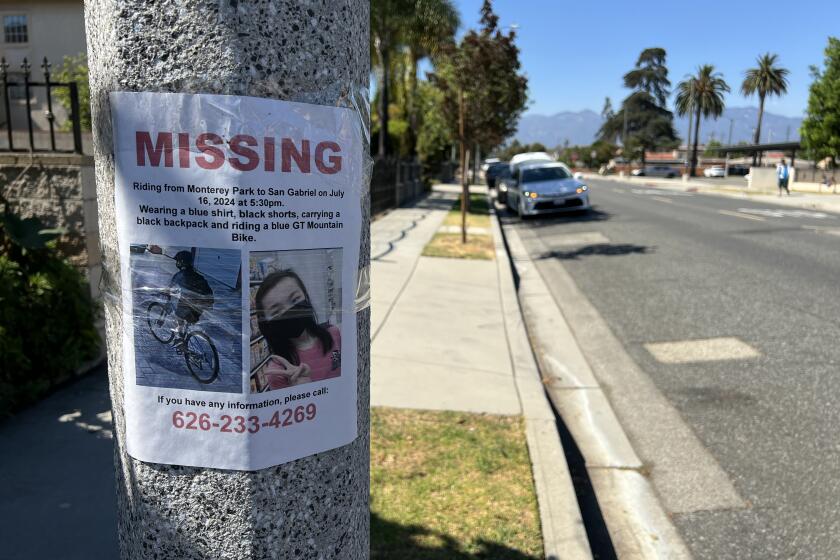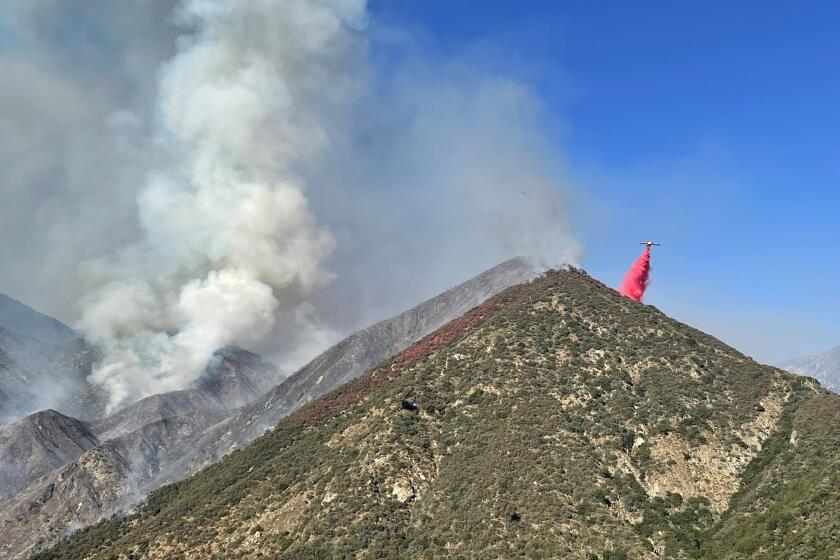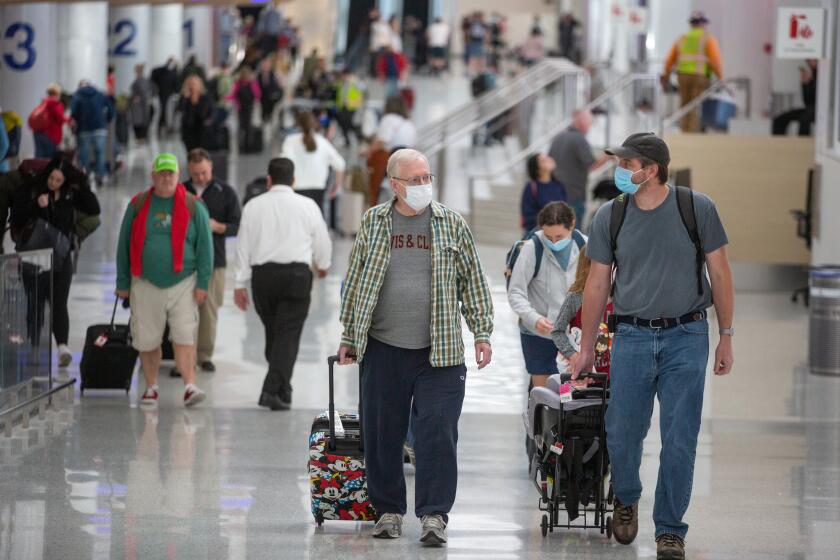Past and Present
The single-starred flag of Communist Vietnam has vanished and its owner, the most hated man in Little Saigon, has been run out of business.
The demonstrators who once camped outside Truong Van Tran’s now-vacant Westminster video store have carted away their ramshackle wooden stage and are moving into a storefront office a few blocks away.
Yet spinoffs from Tran’s crusade, which delivered as many plot twists as the Asian soap operas he once rented from his tiny strip-mall store on Bolsa Avenue, continue to rumble through Orange County and its vast Vietnamese neighborhoods:
* Activists inflamed by the display have taken their first steps toward creating a worldwide campaign to pressure the government of Vietnam over its human-rights record. And the protests have reinvigorated some local efforts, such as a campaign for a Vietnamese community center.
* Westminster and its police force are grappling with the aftermath of emotional, anti-communist protests. Weeks of demonstrations have cost the city at least $200,000 in overtime and angered residents. And Police Chief James Cook is under fire from a police union upset with his response to the protests.
* Tran himself has gone from being an ACLU-backed standard-bearer for freedom of speech to a suspected video counterfeiter facing possible jail time.
When Tran tacked up the flag and a portrait of former Communist leader Ho Chi Minh on his video store wall, he said he wanted to provoke a community dialogue about human rights improvements under the current Vietnamese government.
Instead, his act of defiance sparked a protest that drew as many as 15,000 people and 200 police in riot gear who made 52 arrests over seven weeks. It also welded together the neglected, politically fractured Vietnamese American community, offering up a fleeting taste of political clout and notoriety.
“The crisis over the past two months is definitely a defining moment for the Vietnamese community of Southern California as a whole,” said Van Thai Tran, an attorney and activist.
The protests also drew in dormant segments of the Vietnamese community. The younger generation, previously more interested in the American half of being Vietnamese American, has rediscovered its ethnic identity and become more involved in the community since the protests began, some say.
“The presence of the young generation was recognized by every side,” said Yen Do, publisher of the Westminster-based Nguoi Viet Daily News, one of the largest Vietnamese daily newspapers in the United States. “They tried to contribute as a force, and tried to reshape the trends of the movement.”
Trung Quang Nguyen, an attorney who helped the protesters, said he saw his own son Michael, a high school senior in Irvine, go through a transformation as the protests continued.
“Before the protest, I would say he was lukewarm about the community,” Nguyen said. “But since then, he and his group, particularly the Vietnamese Student Assn. in his high school, they are discussing a lot of things about this.”
The protest itself was generally led by members of the older generation, people who had experienced the effects of the Vietnam War and the Communist regime firsthand, as veterans and political prisoners or relatives of victims killed in re-education camps. But a large contingent of youth groups joined the protests, shifting the focus to the broader issue of human rights in Vietnam, rather than just the video store display itself.
Also, Do said, a middle generation--mainly professionals in their 20s and 30s, fluent in English and well-versed in the ways of American mainstream society--emerged as a powerful force, acting as representatives to the police, media and legislators in Sacramento.
“You have a large segment of the community who was born in Vietnam, but was raised and educated in the United States, and have fully assimilated into the mainstream, but never forgetting their roots and the reasons as to why they are here,” said Van Thai Tran, a 34-year-old attorney who counts himself among the group.
As for the future of the Vietnamese community in Orange County, Do points to a few key dates in coming months: April 30, the anniversary of the fall of Saigon; May 11, declared by Congress as Vietnam Human Rights Day, when protest organizers plan to drive to Washington to lobby the federal government to keep pressure on Vietnam; and July 31, election day for the Vietnamese Community of Southern California Inc., a nonprofit social services agency that also serves as the symbolic head of the local Vietnamese community.
Other efforts in the works that drew inspiration and momentum from the protests include a push for a Vietnamese cultural center or museum in Orange County, and the ongoing attempts by some parents to get Vietnamese classes in public high schools.
*
Not all in Westminster were left glowing by the protests. Councilwoman Margie Rice said she welcomes the political ascension of the city’s Vietnamese Americans, but said the loud rallies and blocked streets only strained their relations with other residents. “Nasty letters” are beginning to pile up in her mailbox, she said.
“They are hard-working and very dedicated people, but they need to shift some of that loyalty to the city that has given them a safe haven,” Rice said. “Where do we draw a line? Where does the freedom stop for one and begin for another?”
Those same questions are being raised within the Police Department, where members of the patrol officers union have criticized Chief Cook’s response to the crisis: one day sending out officers in riot gear, the next day keeping out of sight as demonstrators surrounded Tran’s store.
The grumbling grew loud enough for Cook to call a two-hour staff meeting last Wednesday, attended by 60 of the department’s 102 officers, to hash out the complaints and review the overall police response, said Lt. Bill Lewis, who has negotiated with Tran and demonstrators since the ordeal began.
Officer Brian Carpenter, president of the Westminster Police Officers Assn., declined to comment about the members’ concerns except to say the issues have been discussed.
Lewis said the police response to the protests was often dictated by negotiations with Tran and the demonstration leaders, the goal being to keep the rallies peaceful. Patrol officers were often unaware of those agreements and that, combined with the stress of the protests, created some dissension, Lewis said.
“We had to cancel days off and vacations, and some of us worked for weeks without a day off,” Lewis said. “There’s been a lot of anxiety.”
Ethnic slurs heard over law enforcement radios also have put the department on the spot, prompting an internal investigation that is still underway. So far, the evidence points to an unknown civilian radio operator who apparently infiltrated police radio frequencies, Lewis said.
*
Officers are not the only ones unhappy with how the protests were handled. Tran’s attorneys blame police for letting mobs of demonstrators terrorize their client and overrun his business. They promise that lawsuits against the police, the city and the protesters are lying in wait.
“I don’t think there is any question that the police allowed Mr. Tran to be run out of business,” said Ronald Talmo, who is representing Tran and is affiliated with the American Civil Liberties Union. “It was mob rule.”
Because of that, Tran dropped his legal battle against the landlord of the business complex, Terra Bushard Ltd., which was asking the court to evict the video store owner.
However, Tran’s biggest court battle may begin this week.
Westminster police are expected to seek an arrest warrant against Tran. Lewis said detectives found an elaborate video counterfeiting operation inside Tran’s store during the protests. Police raided the shop in early March, at the same time they were protecting him from protesters, and confiscated 17,000 tapes and more than 100 videocassette recorders.
That same day, police discovered Tran’s store had been burglarized.
Tran’s Vietnamese flag and picture of Ho Chi Minh, which started the whole chain of events, had been stolen. Officers found the back door jimmied.
“It’s been, to say the least, an unusual set of circumstances,” Lewis said.
(BEGIN TEXT OF INFOBOX / INFOGRAPHIC)
How Little Saigon Flag Furor Unfolded
* Jan. 17: Protests begin in front of Hi Tek TV & VCR on Bolsa Avenue in Little Saigon, where store owner Truong Van Tran displays a Communist Vietnamese flag and picture of Ho Chi Minh.
* Jan. 18: Some 400 demonstrators fill shopping center parking lot. Tran is struck in the back of the head as he leaves with police escort.
* Jan. 20: Landlord announces he will evict Tran and seek a court order forcing him to remove the display.
* Jan. 21: Judge issues preliminary injunction ordering Tran to take down the items, granting request by landlord’s attorneys who argued he violated lease conditions by creating a public nuisance.
* Feb. 10: Judge rescinds original order. Tran returns to store and is met by an angry crowd of protesters. He collapses with chest and stomach pains after a light slap on the head from a protester and is hospitalized overnight.
* Feb. 20: Tran and wife Kim Nguyen return to store with police escort to rehang flag and picture. Officers hold back angry protesters, and arrest 31. It is later learned that while inside the store this day, police note indications Tran is running an illegal video piracy operation.
* Feb. 26: Demonstrators hold biggest rally, with an estimated 15,000 people turning out peacefully for a flashlight vigil designed to draw attention to human-rights abuses in Vietnam.
* March 1: Tran is pelted in the face with an egg as he tries to return to his store, then is dragged away by police for his own protection.
* March 5: Police raid Tran’s store and seize more than 17,000 videotapes and 146 VCRs. They also investigate a burglary in which someone apparently broke in through a back door and stole the flag and picture.
* March 8: Tran’s attorneys say he will not return to the store, acknowledging he would be unable to reopen his business.
* March 11: Demonstrations end as landlord removes sign over store. Protest leaders maintain momentum by renting nearby office to host exhibits on human rights violations in Vietnam.
Source: Times reports; Researched by HARRISON SHEPPARD / For The Times
More to Read
Sign up for Essential California
The most important California stories and recommendations in your inbox every morning.
You may occasionally receive promotional content from the Los Angeles Times.







